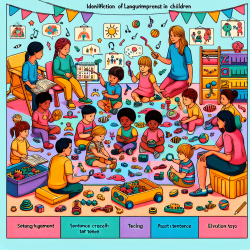Introduction
In the ever-evolving field of speech-language pathology, staying informed about the latest research is crucial for delivering effective interventions. A recent study titled "Diagnostic Accuracy of Sentence Recall and Past Tense Measures for Identifying Children's Language Impairments" provides valuable insights into screening tools that can enhance our ability to identify language impairments in children. This blog post will delve into the findings of this study and explore how practitioners can leverage these insights to improve outcomes for children.
The Study: An Overview
The study conducted by Redmond et al. (2019) examined the diagnostic accuracy of sentence recall and past tense marking measures in identifying language impairments in children. The research involved 1,060 students from grades K-3, with a focus on determining how well these measures could identify language impairments compared to various reference standards. The results showed varying levels of diagnostic accuracy, with areas under the receiver operating characteristic curves ranging from 0.67 to 0.95.
Key Findings
- Sentence recall and past tense marking measures demonstrated high diagnostic accuracy when compared to behavioral reference standards.
- Higher convergence was observed with reference standards based on behavioral measures rather than service receipt or parental concern.
- The study supports the adaptation of these measures for screening language impairments in early elementary students.
Implications for Practitioners
For practitioners, the study's findings highlight the importance of incorporating sentence recall and past tense measures into language screening protocols. These tools offer a reliable method for identifying language impairments, particularly when used alongside behavioral reference standards. By adopting these measures, practitioners can improve the accuracy of their screenings and ensure that children receive the necessary interventions at an early stage.
Encouraging Further Research
While the study provides a strong foundation for using sentence recall and past tense measures, it also opens the door for further research. Practitioners are encouraged to explore additional reference standards and investigate how these measures can be adapted for diverse populations. Continued research in this area will enhance our understanding of language impairments and lead to more effective screening and intervention strategies.
Conclusion
Incorporating data-driven measures like sentence recall and past tense marking into language screening protocols can significantly improve our ability to identify language impairments in children. By leveraging the insights from this study, practitioners can enhance their screening processes and contribute to better outcomes for children with language impairments.
To read the original research paper, please follow this link: Diagnostic Accuracy of Sentence Recall and Past Tense Measures for Identifying Children's Language Impairments.










